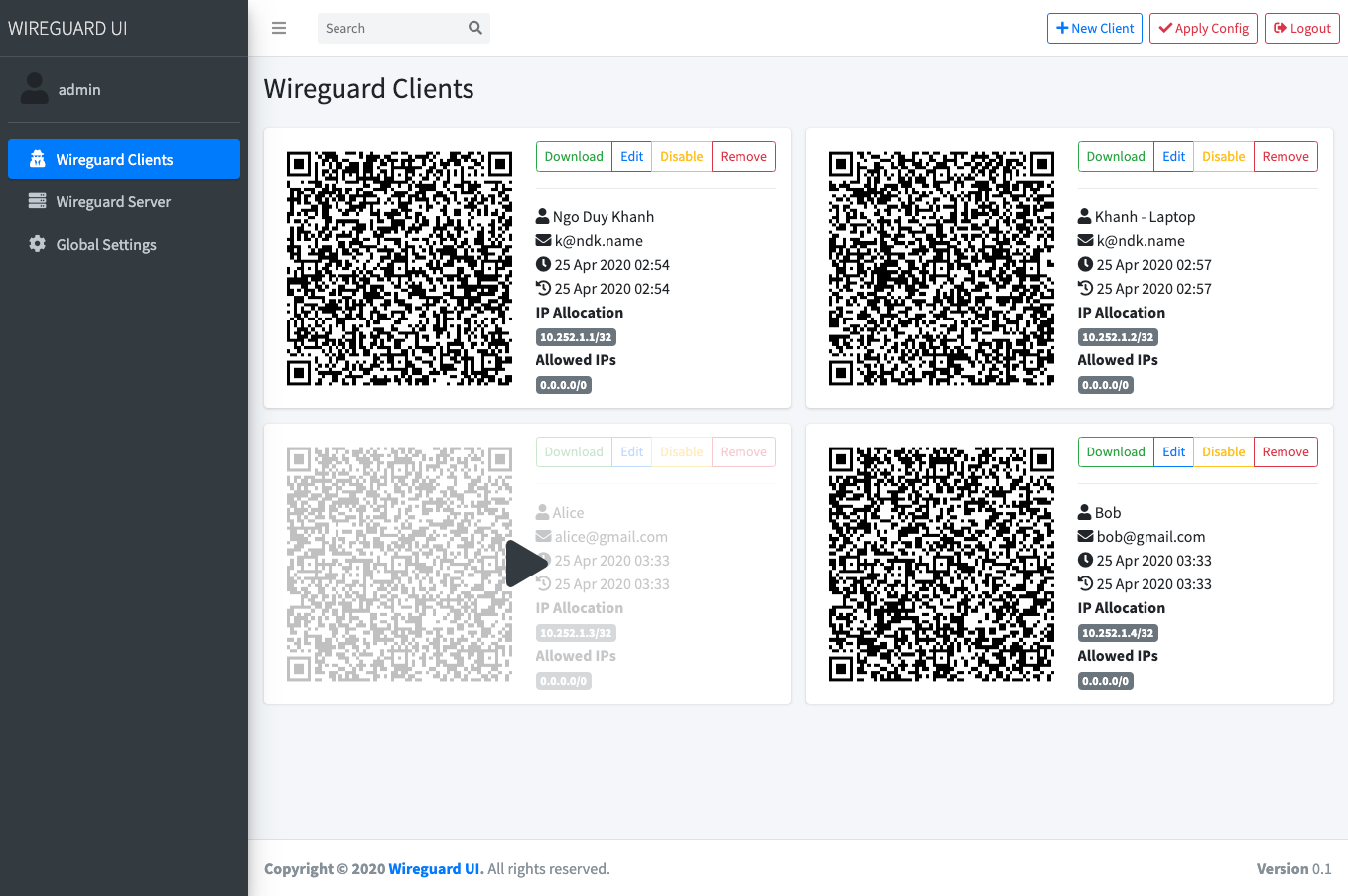|
|
||
|---|---|---|
| .github | ||
| custom/js | ||
| db | ||
| emailer | ||
| handler | ||
| model | ||
| router | ||
| store | ||
| templates | ||
| util | ||
| .dockerignore | ||
| .gitignore | ||
| Dockerfile | ||
| Jenkinsfile | ||
| LICENSE | ||
| README.md | ||
| docker-compose.yaml | ||
| go.mod | ||
| go.sum | ||
| main.go | ||
| package.json | ||
| prepare_assets.sh | ||
| yarn.lock | ||
README.md
wireguard-ui
A web user interface to manage your WireGuard setup.
Features
- Friendly UI
- Authentication
- Manage extra client's information (name, email, etc)
- Retrieve configs using QR code / file
Run WireGuard-UI
Default username and password are admin.
Using docker compose
You can take a look at this example of docker-compose.yml. Please adjust volume mount points to work with your setup. Then run it like below:
docker-compose up
Note:
There is a Status option that needs docker to be able to access the network of the host in order to read the
wireguard interface stats. See the cap_add and network_mode options on the docker-compose.yaml
Environment Variables
| Variable | Description |
|---|---|
SESSION_SECRET |
Used to encrypt the session cookies. Set this to a random value. |
WGUI_USERNAME |
The username for the login page. (default admin) |
WGUI_PASSWORD |
The password for the user on the login page. (default admin) |
WGUI_ENDPOINT_ADDRESS |
The default endpoint address used in global settings. (default is your public IP address) |
WGUI_DNS |
The default DNS servers (comma-separated-list) used in the global settings. (default 1.1.1.1) |
WGUI_MTU |
The default MTU used in global settings. (default 1450) |
WGUI_PERSISTENT_KEEPALIVE |
The default persistent keepalive for WireGuard in global settings. (default 15) |
WGUI_FORWARD_MARK |
The default WireGuard forward mark. (default 0xca6c) |
WGUI_CONFIG_FILE_PATH |
The default WireGuard config file path used in global settings. (default /etc/wireguard/wg0.conf) |
Defaults for server configuration
These environment variables are used to control the default server settings used when initializing the database.
| Variable | Description |
|---|---|
WGUI_SERVER_INTERFACE_ADDRESSES |
The default interface addresses (comma-separated-list) for the WireGuard server configuration. (default 10.252.1.0/24) |
WGUI_SERVER_LISTEN_PORT |
The default server listen port. (default 51820) |
WGUI_SERVER_POST_UP_SCRIPT |
The default server post-up script. |
WGUI_SERVER_POST_DOWN_SCRIPT |
The default server post-down script. |
Defaults for new clients
These environment variables are used to set the defaults used in New Client dialog.
| Variable | Description |
|---|---|
WGUI_DEFAULT_CLIENT_ALLOWED_IPS |
Comma-separated-list of CIDRs for the Allowed IPs field. (default 0.0.0.0/0) |
WGUI_DEFAULT_CLIENT_EXTRA_ALLOWED_IPS |
Comma-separated-list of CIDRs for the Extra Allowed IPs field. (default empty) |
WGUI_DEFAULT_CLIENT_USE_SERVER_DNS |
Boolean value [0, f, F, false, False, FALSE, 1, t, T, true, True, TRUE] (default true) |
WGUI_DEFAULT_CLIENT_ENABLE_AFTER_CREATION |
Boolean value [0, f, F, false, False, FALSE, 1, t, T, true, True, TRUE] (default true) |
Email configuration
To use custom wg.conf template set the WG_CONF_TEMPLATE environment variable to a path to such file. Make sure wireguard-ui will be able to work with it - use default template for reference.
Set the BASE_PATH environment variable if you run wireguard-ui under a subpath of your reverse proxy virtual host (e.g. /wireguard).
In order to sent the wireguard configuration to clients via email, set the following environment variables:
- using SendGrid API
SENDGRID_API_KEY: Your sendgrid api key
EMAIL_FROM_ADDRESS: the email address you registered on sendgrid
EMAIL_FROM_NAME: the sender's email address
- using SMTP
SMTP_HOSTNAME
SMTP_PORT
SMTP_USERNAME
SMTP_PASSWORD
SMTP_AUTH_TYPE
EMAIL_FROM_ADDRESS: the sender's email address
EMAIL_FROM_NAME: the sender's name
Using binary file
Download the binary file from the release and run it with command:
./wireguard-ui
Auto restart WireGuard daemon
WireGuard-UI only takes care of configuration generation. You can use systemd to watch for the changes and restart the service. Following is an example:
systemd
Create /etc/systemd/system/wgui.service
[Unit]
Description=Restart WireGuard
After=network.target
[Service]
Type=oneshot
ExecStart=/usr/bin/systemctl restart wg-quick@wg0.service
[Install]
RequiredBy=wgui.path
Create /etc/systemd/system/wgui.path
[Unit]
Description=Watch /etc/wireguard/wg0.conf for changes
[Path]
PathModified=/etc/wireguard/wg0.conf
[Install]
WantedBy=multi-user.target
Apply it
systemctl enable wgui.{path,service}
systemctl start wgui.{path,service}
openrc
Create and chmod +x /usr/local/bin/wgui
#!/bin/sh
wg-quick down wg0
wg-quick up wg0
Create and chmod +x /etc/init.d/wgui
#!/sbin/openrc-run
command=/sbin/inotifyd
command_args="/usr/local/bin/wgui /etc/wireguard/wg0.conf:w"
pidfile=/run/${RC_SVCNAME}.pid
command_background=yes
Apply it
rc-service wgui start
rc-update add wgui default
Build
Build docker image
Go to the project root directory and run the following command:
docker build -t wireguard-ui .
Build binary file
Prepare the assets directory
./prepare_assets.sh
Then you can embed resources by generating Go source code
rice embed-go
go build -o wireguard-ui
Or, append resources to executable as zip file
go build -o wireguard-ui
rice append --exec wireguard-ui
Screenshot
License
MIT. See LICENSE.
Support
If you like the project and want to support it, you can buy me a coffee ☕
